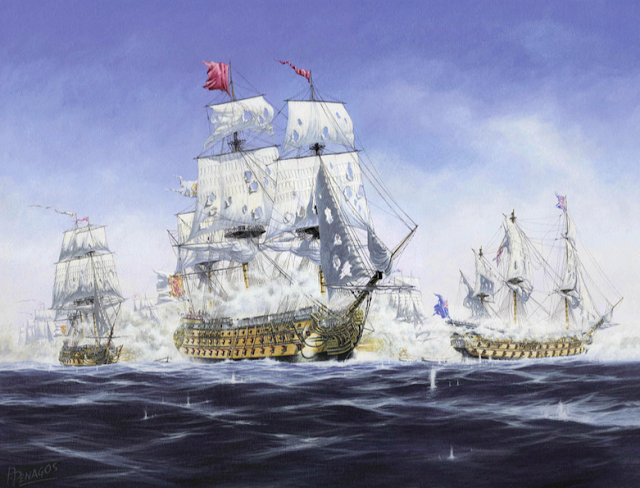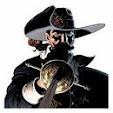Many British and some visitors to Hacienda Riquelme have used the ferry linking Plymouth with Santander.
The city of Santander is located by the Cantabrian Sea. It has a large bay, at the background of which was the Real Astillero (Royal Shipyard) of Guarnizo, where many of the best ships of the Bourbon's Navy were built. It ceased activity late in the eighteenth century, following the entry into service of the arsenals of Ferrol, Cadiz and Cartagena (see The Arsenal of Cartagena).
At Guarnizo they built the Real Felipe (Royal Philippe), the first ship of the line of first class made in Spain in the XVIIIth century, capable of carrying up to 114 guns on three decks. She was the only ship of these features built according to the Gaztañeta system, with design attributed to Ciprian Autrán. She was also the only one of her kind made in the Cantabrian shipyard and was known as Pride of Guarnizo.
The Real Felipe was named in honour of Felipe (Philip) V, the first king of Spain of the Bourbon dynasty. She was put on the slipway in 1731 and was launched in 1732. The lower battery had 30 36-lbs bronze cannons. Iron cannons of the remaining batteries were smelted in the nearby factory of La Cavada (see Cartagena and the Royal Artillery Factory of La Cavada).
The ship was fast and navigated very well with calm sea, but presented quite a few problems with rough sea due to a construction that resulted of lower quality than the design.
 |
| The Real Felipe leaving astern Santander Bay and Mouro Island. Courtesy of Carlos Parrilla. |
 |
| Click on the picture to enlarge it |
Almost two years later, on February 19, 1744, this squadron went to sea, sailing south. Simultaneously the British did the same from its near base in Hyères.
The commander of the French squadron was the old but energetic Admiral Claude-Élisée de Court, who had many disagreements with the commander of the Spanish squadron, Admiral Juan Jose Navarro, very prestigious for his technical and scientific works. The commander of the British squadron was the veteran Admiral Thomas Mathews.
On February 22, both fleets clashed at the Battle of Cape Sicie (aka Battle of Toulon).
The French-Spanish battle line consisted of 9 French ships in the vanguard, 6 French and 3 Spanish in the centre, and 9 Spaniards in the rearguard, a total of 27 ships.
The British battle line was formed by a vanguard with 9 ships, a centre with 10, and rearguard with 13, a total of 32 ships.
France was not yet technically at war with Great Britain so its ships were ordered not to fire unless the British did so first.
The British line was sailing in parallel and somewhat behind the French-Spanish. In addition, the British rearguard was very behind.
Mathews decided to attack when he saw that the Spanish rearguard was sailing with some disorder (5 ships were also left behind) and that the powerful Real Felipe, Navarro's flagship, was left with the close support of only 2 ships.
The British vanguard clashed with the Franco-Spanish centre, while the British centre did the same with the Spanish rearguard. It was here where the hardest fighting took place. The Real Felipe took the worst part, being completely dismantled, not without first causing serious damage to the British ships Namur, Mathews' flagship, and Marlborough.
 |
| The picture depicts the battle of Cape Sicie at the moment when the HMS Namur (90 guns), Admiral Mathews' flagship, has to retire severely damaged by the fire of the Real Felipe (110 guns), Admiral Navarro' flagship. Courtesy of Carlos Parrilla. |
De Court proposed to Navarro attacking the English but the state of the Spanish ships made them reject the idea.
At dawn on the 23th, the Franco-Spanish squadron began to sail west. However, they were disordered and chased by the British, engagiing in some minor fights. The following day, Mathews ordered to withdraw to the base at Mahon, in the Menorca Island, under English rule by these years. There he would repair the ships and resume his mission of guarding the Italian coast.
The ships of the allied squadron reached several Spanish ports, most of them in Cartagena.
The Real Felipe was the main protagonist of the battle of Cabo Sicie, resulting in such damage that she had to be towed to the arsenal of Cartagena, never to sail again. It was scrapped in 1750, 18 years after being launched.
The outcome of the battle and the actions of the contenders were and still are much discussed. From a tactical point of view, the battle resulted in a draw. But the fact is that the combined squadron managed to break the blockade that was under way in Toulon, resisted the attack of the British squadron, and regained for a few months the dominance of the western Mediterranean.
In England, several war councils were held ending with a verdict, in which Mathews was convicted of various charges and expelled from the Navy.
In Spain, the battle was considered a triumph and Navarro was named Marquis de la Victoria.
De Court was relieved of command on his arrival in Cartagena, after being accused by several Spanish captains of a supposed abandonment by the French ships.
Spain did not have more first class ships of the line until years later, when it was decided to build in the shipyard of Havana the Santísima Trinidad (Holy Trinity), which was launched in 1769.
 |
| View of the Real Felipe by her starboard side sailing through Santander Bay between the city and the sand of El Puntal. Courtesy of Carlos Parrilla. |
Carlos Parrilla (website)
Real Felipe (1732) (Spanish Wikipedia)
Navío Real Felipe. José Ignacio González-Aller Hierro (todoababor.es)
Batalla de Tolón (Spanish Wikipedia)
Battle of Toulon (1744) (English Wikipedia)
La campaña de don Juan José Navarro en el Mediterráneo y la batalla de Sicié (1742-1744) (todoababor.es)
El navío de tres puentes en la Armada española. José Ignacio González-Aller Hierro (todoababor.es)
El navío de línea español (todoababor.es)
Navíos de línea de la Armada Española (Spanish Wikipedia)
List of ships of the line of Spain (English Wikipedia)
Listado de los navíos de línea de la Real Armada española (todoababor.es)
Related books
Historia de la Armada Española desde la unión de los reinos de Castilla y de Aragón. Cesáreo Fernández Duro
El buque en la Armada Española. Enrique Manera Reguera (director) and others. Editorial Silex. Bilbao 1981
España y el mar en el siglo de Carlos III. Vicente Palacio Atard (coordinator) and others. Marinvest, S.A. Madrid 1989
Victorias por mar de los españoles. Agustín Ramón Rodríguez González. Grafite Ediciones. Madrid 2006
22 derrotas navales británicas. Víctor San Juan. Ediciones Navalmil. Madrid 2014
Related posts
Cartagena and the Royal Artillery Factory at La Cavada
Cartagena y la Real Fábrica de Artillería de La Cavada
The Arsenal of Cartagena
El Arsenal de Cartagena
Voyage of the Glorioso
Carrera del Glorioso
Blas de Lezo y la batalla de Cartagena / Blas de Lezo and the battle of Cartagena
Una derrota de Nelson cerca de Cartagena / Nelson’s defeat near Cartagena
Nuestra Señora de las Mercedes







%20hundi%C3%A9ndose.jpg)

No hay comentarios:
Publicar un comentario